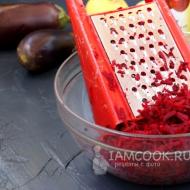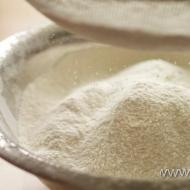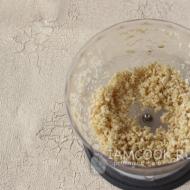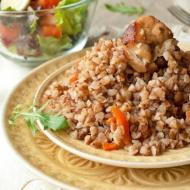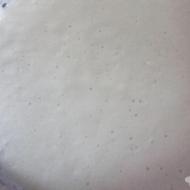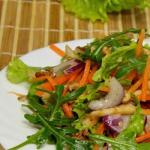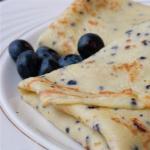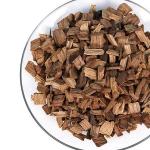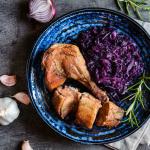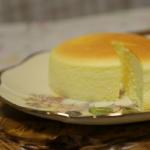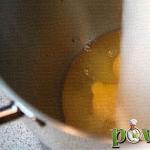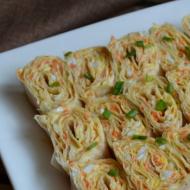
The most delicious homemade fruit jams, recipes with photos and videos. Frozen raspberry confiture. Rhubarb jam with lemon and ginger
Both in appearance and in its properties jam different from jam. Jam- this is a tasty, thick, jelly-like mass of berries or fruits. Jam You can cook not only from one type of fruit or berry, but also combine fruits: for example, apple-plum jam, apple-cherry jam, strawberry jam with lemon, and so on. Jam also differs favorably from preserves in that ripe or slightly unripe fruits and berries are suitable for it: overripe and crushed fruits contain little pectin, and jam prepared from them will not gel. When preparing jam, you need to take at least 1 kg of sugar per 1 kilogram of any fruits and berries. The readiness of the jam is determined both by its boiling point, which should be at least 105 C, and by its appearance. The finished jam should be thick, jelly-like, and when chilled it will not spread over the plate.
There are 188 recipes in the "Jams" section
Orange jam
There are some features of the orange jam recipe. Be sure to remove the white pulp and seeds, otherwise the jam will turn out bitter. Although, as I learned, in Spain they use the whole fruit to make jam - the seeds contain a lot of pect...
Apple and grape jam
A recipe for an unusual jam made from apples and grapes, which is guaranteed to be the first thing eaten in winter. Because it is not only tasty, but also has a pleasant fresh sourness, reminiscent of summer. By the way, this jam is quite suitable as a filling for a pie...
Red plum jam
Red plum jam is perhaps the easiest homemade fruit jam to make. The jam recipe is so simple that even a novice cook can do it. There is enough pectin in plums and therefore jam and preserves from it turn out thick without...
Apple jam with melon, ginger and dried oranges
Italians don’t like sweets too much, but if they decide to cook them, they always create something original. The recipe for apple jam with melon, ginger and dried oranges is one of these. It is difficult to call them the prosaic word “jam”. Any recipe...
Apple jam with dogwood
Apple jam with dogwood is not only delicious, it is also healthy. Thanks to juicy and ripe apples, the rich, slightly tart taste of dogwood becomes softer and more refined. If you prefer a smooth jam texture, you can steam it...
Plum and peach jam for the winter
The principle of making plum-peach jam is so simple that even an inexperienced cook can handle the recipe. The main thing is to strictly follow all the described steps, use only ripe, juicy fruits and have any kitchen gadget that...
Apple-plum jam with lemon
We offer a recipe for apple and plum jam with lemon. It successfully combines light citrus sourness and a bright plum aroma. The homogeneous texture of the jam is obtained by cooking over low heat. Thick plum and apple jam can be served simply with tea and...
Apricot jam with lemon
This apricot jam recipe differs from most similar recipes by adding pectin during cooking. This means that the jam will thicken perfectly much faster than usual and retain maximum taste and aroma of fresh juicy apricots. Moreover, ...
Apricot-peach jam for the winter
The recipe for making peach and apricot jam will bring back memories of sunny summers in winter. The delicate taste thanks to peaches, the bright, incredibly colorful color thanks to apricots and the thick texture make the jam a mega-popular winter sweet. Propor...
Peach jam with pectin
Peaches are so tender that they do not tolerate long cooking. But what if you want to make peach jam for the winter? The solution is simple - use pectin. If you add a certain amount of pectin to lightly boiled peach puree, then...
Rhubarb jam with lemon and ginger
A recipe for rhubarb jam with lemon or orange is a good option to diversify sweet preparations for the winter. The succulent stems of rhubarb can be harvested throughout the spring and summer months. By choosing only fresh and young raw materials (without coarse fibers and...
Currant jam
Currants are an incredibly healthy berry. When it is ripe, it acquires a unique aroma and a sweetish-sour taste. Its berries, depending on the variety, can be black, yellow and red. This recipe for yellow-amber currant jam...
Lilac jam with lemon
Thick lilac jam is served for breakfast, spread on sandwiches made of rye bread with butter. The jam can be called citrus-floral. Lemon freshness successfully complements the taste of flowers mixed with sugar, and somewhere in the background...
Orange and tangerine jam
Homemade jam from oranges, lemons and tangerines is easy to make. The recipe is simple and does not require any skills. It is important to prepare the fruit for cooking so that there is no bitterness left from the citrus peels. How to do this, read below. Citrus jam can...
Pineapple jam with agar-agar
This recipe uses agar agar to thicken the pineapple jam. Unlike gelatin, agar can and should be boiled with fruit to thicken the finished product. Pineapple jam can be served with tea, like regular jam, or added to baked goods...
Isabella grape jam with apple pectin
The finished jam from Isabella grapes tastes like wine - tart, with a currant-like aftertaste. For cakes, grape jam, it seems to me, will be ideal if you make sweet cakes and sweet cream. Well, in the meantime, the jam is on the gr...
Pitted cherry jam with pectin
You can cook seedless cherry jam less than usual and make the syrup thicker by adding pectin during cooking. By pouring hot cherries in syrup into jars and tightly sealing the lids, the jam can be stored without a refrigerator, simply hidden in a box. ...
Apples are the most common fruit in our country, so they were eaten fresh and processed. They are the most accessible to any family. Therefore, almost every housewife prepares apple jam for the family for the winter during the appropriate period. After all, this sweet is loved by both children and adults: it can be spread on bread or pancakes, and it is perfect as a filling for pies.
Cooking jam is very similar to making jam: it is checked for readiness in the same way - a small amount is dripped onto a snack plate and made sure it does not spread.
But there are also differences in the technological process:
- the finished dish should be poured into jars while hot, otherwise it will thicken right in the container where it was cooked;
- In order to achieve a light color of the product, you need to pour salt water (1 liter of liquid and 1 tablespoon of salt) into the fruit for 15 minutes before heat treatment.
How to choose and prepare apples correctly
Any variety of apples is suitable for making jam, but sweet and sour fruits are especially good. Moderately ripened fruits make jam into pieces, and overripe fruits are suitable for a dish with a uniform consistency.
To make jam, take ripe fruits. Preparing fruits involves washing, cutting out blemishes and cores with seeds. The apples are then sliced or grated to speed up their cooking.
You can remove the skin from the fruit as desired, but you need to keep in mind that the skin on apples contains pectin, and it will be more difficult to achieve a jelly-like consistency without it. If it is left, then after cooking the pulp is rubbed through a sieve.
How to make apple jam at home
Most often, jam is prepared with the addition of sugar; heat treatment is used to cook it. Apple sweets differ from each other in the presence of various ingredients and consistency, as well as appearance. Therefore, there are many recipes that combine various ingredients and the consistency of the components of the sweet product in different ways.
A simple recipe for the winter
For jam, quickly prepared according to a simple recipe, you only need to add fruit and sugar in equal quantities. Step by step it is prepared like this:
- the prepared fruits are placed on the bottom of the container in which they will be cooked and sprinkled with granulated sugar;
- leave for a while and begin to bring to a boil, stirring;
- when the jam boils, reduce the power of the stove and continue stirring;
- cook for 40 minutes, skimming off the foam.
If you want to get thick jam and have a homogeneous consistency, then at the end of cooking, beat the mass with a blender. After the preparation process is completed, the product is placed in sterilized jars and sealed.

Apple confiture with cinnamon and lemon
This apple product has a richer flavor than regular jam because it is cooked with lemon and cinnamon.
Ingredients:
- apples;
- sugar;
- lemon;
- water;
- cinnamon.
Refined sugar is poured into water and syrup is boiled. At the same time, prepare the apples. Then they are grated on a coarse grater and placed in syrup. Cook for an hour, stirring. At the end of the cooking process, add lemon juice and cinnamon. Everything is poured into sterilized jars and hermetically sealed.
Apple jam with lingonberries
This is an old recipe that combines apples and lingonberries, and many people still want to make it today.
Recipe ingredients:
- apples;
- cowberry;
- water;
- lemon acid;
- granulated sugar;
- gelling agent;
- vanilla sugar.

Prepared apples are separated from the skin and core. Then they take a pan and put in what was trimmed from the fruit. A solution is prepared in another container: water is poured in and citric acid is poured in, and then the fruit pulp, which is cut into slices, is immersed in it. The apples are infused in this solution for some period.
After keeping the fruit pulp in acidic water, it is poured into the container where the skins are located. Then this pan is placed on the fire and boiled for 3 minutes. The pectin from the skin goes into solution and thus the jam will become thicker.

After cooking, strain and pour the liquid back into the first pan. Boil the fruits for 10 minutes until they are softened. After this, puree with a blender, but not completely, and leave some of the pieces and add lingonberries.
The next step is to mix vanilla with regular sugar and add a gelling agent. Place on the fire and, stirring, leave for 5 minutes. Remove the boiling product and pour into prepared jars, roll up with iron lids.

In a slow cooker
Modern technology can greatly simplify the process of making apple jam. Making it in a slow cooker is very easy.
Ingredients:
- apples;
- sugar;
- water.
The fruits are prepared and the skin is removed. It is loaded into the bowl of the device, select the “Steam” function and leave for 10 minutes. Then a liquid containing pectin remains in the container, into which chopped apples and sugar are placed.
After this, turn on the “Quenching” mode and leave for 60 minutes. After preparation, pack into sterilized containers and roll up.
With orange
If you cook this aromatic jam correctly, children will especially like it.
Ingredients:
- orange;
- apples;
- water;
- sugar.
Boil the apples in water and remove them, and add sugar and chopped orange to the remaining liquid. Grated apples are also returned here. Stirring, keep them on the fire for a quarter of an hour. Pour into sterile containers and seal.

With chokeberry
This jam is a vitamin product due to the properties of chokeberry.
Recipe ingredients:
- apples;
- Rowan;
- sugar;
- water.
The prepared fruits are cut into slices along with the skin and core. At the same time, the berries are also prepared. Pour water into the pan and blanch the black rowan for 5 minutes. Then add apples and cook for 20 minutes, stirring. Remove the container from the heat, cool and grind.
Add sugar to the resulting puree and cook for about an hour, stirring. Place into prepared jars and seal.
In the bread machine
This technique is quite suitable for making jams, since it has a “Jam” mode.
Components:
- apples;
- sugar.
The prepared fruits are grated on a fine grater. Then the puree is put into the device and sugar is given. Set it to the desired mode and leave it to cook. At the end, they are laid out in sterile jars and covered with lids.

Sugarless
You can make wonderful jam without the presence of sugar.
Components:
- apples;
- water.
Pieces of fruit are poured with water and boiled for 20 minutes. Then the mass is ground or pureed with a blender. If you need a product with greater thickness, boil it again for several minutes. Pour into prepared jars and roll up.
Without sterilization
You can make preparations for the winter without sterilization, limiting yourself to pasteurization.
Components:
- apples;
- sugar;
- water.
The prepared fruits are cut into cubes, and water is boiled at the same time. Blanch the fruit for 10 minutes. Then the fruit is combined with sugar and half of the liquid remaining after blanching is added. Cook until done. Stir occasionally. Pour into jars and seal.
What to make jam fromJam is made from fruits and berries, the choice being mainly based on the season. In May, jams are made from apricots and strawberries. In June, jams are made from currants (red and black) and cherries and strawberries. In mid-summer they begin to cook from raspberries, apples and plums. In August and early September, jams are made from lingonberries, gooseberries, and hawthorns. As a rule, each stage of the fruitful season has its own “golden” time, when you can buy fruits and berries at a very low price in the market or in villages. Especially if there is a good harvest, they will give it away at a big discount, just to get rid of poorly stored products.
How long to cook jam
Depending on the type of fruit and juiciness, the cooking time will be 15-25 minutes.
Should I add pectin (agar-agar, gelatin)
The main highlight of the jam is its pleasant jelly structure, which, by the way, makes the jam moderately sweet and high in calories. Therefore, in general cases, pectin is useful.
Natural pectin is found in apples and apricots, gooseberries, plums and currants. However, when cooking, keep in mind that jam made from them without pectin will need to be boiled for quite a long time and it will turn out very concentrated.
How to cook - general rules
1. Wash the fruits and shake lightly in a colander to remove excess moisture. Bones, if present, should be removed.
2. Add sugar and wait 1-8 hours, depending on the type of fruit, for them to give juice.
3. Prepare the gelling component: for example, gelatin should be diluted with water and heated (the exact recipe depends on the type of gelatin). 4. Rub the fruits through a sieve, remove the skins, place the mixture in a saucepan and simmer for 10 minutes.
5. Pour in pectin, mix thoroughly, turn off the heat when it boils.
What to add to jam
Firstly, when making jam, you can combine fruits and berries with each other. In any jam, citric acid and, of course, spices will be appropriate - star anise, cardamom, cinnamon, cloves, and less often black pepper.
You can add nuts to the jam - almonds or walnuts. You can add raisins or prunes from dried fruits.
Jam is a jelly-like mass containing whole fruits and berries boiled in sugar syrup, or the same ones, but cut into pieces. How is jam different from preserves? Unlike the latter, the syrup in jams is not separated from the fruits, but forms a single thick mass with them. The fruits themselves are soft and boiled. A type of jam - confitures have a denser structure than jams.
In many countries (eg England) jams– the only type of fruit preserved with sugar. In our country, jams are a fairly popular preparation for the winter. After all, jams are very convenient for making pies and sweet pies, since they are more heat-stable than preserves and usually do not spread during baking. For making jams They use fruits with a high content of pectin, a substance that determines the jelly-like consistency of jams. Apples, quince, apricots, plums, currants, and gooseberries are rich in pectin substances. Unripe fruits contain more pectin. But usually when preparing jams, they proceed as follows - add a small amount of unripe, sour fruits to ripe fruits. When using fruits poor in pectin, gelling additives are added - juices and fruits rich in pectin, gelatin, agar-agar. If you do everything right, then make jam from your favorite fruits or berries it will be easy and simple.
There are two ways to make jams.
- First way Suitable for fruits and berries rich in pectin.
- The fruits are pre-cooked for 10-15 minutes so that the pectin of fruits or berries better demonstrates its gelling properties. The fruit decoction or part of it is used to prepare sugar syrup. Sometimes the broth is pre-filtered. In some recipes, the fruits are additionally boiled in a small amount of water (per 1 kg of ripe fruits - 50 ml of water, unripe - 100 ml) so that they release juice.
- The boiled fruits are covered with sugar (if soft, well-ripened fruits or berries are used) or poured with sugar syrup. When preparing blackcurrant (or gooseberry) jam, the berries are slightly crushed for better soaking in sugar syrup. Boil until done, pour hot into hot sterilized jars, roll up, and store in the cold.

- The fruits are preheated with sugar, and then poured with pectin extract or juice with a high content of pectin substances, or other gelling agents are added.
- Boil the jam until ready. Pour into jars and seal.
Features of jam cooking:
- Preparation operations must be carried out quickly to prevent the pectin substances from being destroyed.
- Begin cooking jams over high heat - this destroys enzymes that are destructive to pectin. Therefore, it is best to prepare jams in a container with a thick bottom and low walls, which imposes a limit on the number of fruits - no more than 1.5 kg per cooking.
- It is advisable to add sugar (in recipes where syrup is not used) in small portions so as not to interrupt the cooking process.
- Check the readiness of the jam by the way it drips from the spoon. The finished jam drips from the spoon like a thin thread. If it drops, continue cooking. If the cooled jam falls off the spoon in pieces, then it is ready and can be removed from the stove. A cooled drop of finished jam wrinkles (the surface is not smooth). When rubbed, cooked jam does not stick to your fingers. If you have a technical thermometer, then the temperature of the finished jam should be 106.5-107 degrees if it is not further sterilized, and 104-105 if it needs to be pasteurized.
In this article we will figure out how to make jam correctly. Jam is a jelly-like mass with pieces of fruits or berries boiled in syrup. Good jam can be made from berries and fruits that have certain properties.
From the same berries you can make jam, jelly, jam, marmalade or jam. Thick, well-gelling jam will be obtained from sour fruits (acidity more than 1%) containing a large amount of pectin. Pectin in the presence of sugar and organic acids forms a jelly-like consistency.
How to make jam for the winter
Jam differs significantly from jam precisely in its gelling properties and density. Unlike jam, the syrup in jam does not separate from the fruit. Read about the difference between jam and preserves in the article:
If a test cooking showed that after cooling the jam is not dense enough and does not gel well, more like jam, this means that there is not enough acid in the fruit. In such a situation, add the juice of one of the sour fruits. You can read about the acidity of fruits in the article:.
Juice is added in an amount of 10-15% to the original weight of raw materials. Most pectin substances are found in unripe fruits. To make good quality jam, take ripe fruits of excellent quality, adding to them a small amount of unripe fruits.
The jam is cooked quickly to prevent the destruction of pectin. The jam is cooked over high heat in a container with a wide bottom and low walls. It is best to make jam from already proven berries or fruits that contain a lot of pectin and acid. Excellent jam is made from strawberries, raspberries, plums, apples, apricots, cranberries, currants, and gooseberries.
Before making jam, fruits and berries must be prepared
- Apricots, plums, and peaches should be pitted. Grind the fruits.
- Berries such as currants, cranberries, gooseberries are pre-crushed (passed through a meat grinder or ground in a blender).
- When jam is cooked, a puree-like mass is obtained that is uniform in consistency and has excellent gelling properties.
- Apples, plums, cherries or figs are pre-boiled in a small amount of water. The prepared fruits are placed in a pan and poured with hot water so that the water covers only the top layer and the fruits do not burn.
The water is brought to a boil and the fruits are simmered for several minutes until softened. In this case, many useful substances pass from the fruits into the water. If you cook jam in several stages, then you can boil the fruits in the same water several times. The syrup will be rich in sugar and acid, which will improve the quality of the jam.
- To pre-soften the fruit, take 100 ml (half a glass) of water per 1 kg of berries, and only then add sugar.
All this is done so that the pectin contained in fruits and berries has a better gelling effect, and the berries are completely saturated with sugar.
For 1 kg of prepared raw materials for making jam, it is required
- Strawberries, plums, peaches, figs 1 kg sugar
- Apricots, apples, quinces 1.2 kg sugar
- Cranberries, black currants 1.5 kg
The finished jam is packaged in pre-prepared glass jars and sealed.
How to make jam from garden berries
Excellent jam - confiture is made from a mixture of garden berries. This is a proven recipe that is a hit with our family. All berries have sufficient acidity and gel well.
Blackcurrant, gooseberry and raspberry jam
To make jam we will need:
- Blackcurrant 2 cups
- Gooseberries 2 cups
- Raspberries 1 cup
- Sugar 5 glasses
- The berries must first be prepared. Sort the raspberries, sort the currants and wash.
- Trim the stems and tails of the gooseberries with small scissors. Combine the berries together and grind through a meat grinder.
- You will get a homogeneous berry mass. Add sugar to this mass in a 1:1 ratio - for 5 cups of berries add 5 cups of sugar.
- Transfer the berry mass to a cooking bowl and let stand for 15-20 minutes.
- Place on the fire, bring to a boil and cook for only 5 minutes, constantly skimming off the foam.
- Remove from heat and let stand for 15-20 minutes. It is not recommended to allow it to cool completely.
- Put it on the fire a second time, bring it just to a boil and immediately remove it from the heat.
- Cool the finished jam and put it into sterilized jars.
This jam can also be made from frozen berries. If the berries in the garden ripen unevenly, then black currants or raspberries can be frozen in the required quantity and then used to make jam.
The article provides two proven recipes for raspberry jam, with and without syrup. How to make delicious raspberry jam.
Raspberries are a source of culinary inspiration and preparations for the winter. Raspberry jam is most likely an exquisite dessert.



